
| Información |  | |
Derechos | Equipo Nizkor
| ||
| Información |  | |
Derechos | Equipo Nizkor
| ||
12may15
Gallery of Photographs of the ceremony unveiling a plaque to honour Anna Pointner.
Anna Pointner was an Austrian civilian, a resident of the town of Mauthausen, who had the courage to resist National Socialism and to help the Spanish Republicans who were prisoners in the Mauthausen concentration camp.For that reason, the unveiling of this plaque has such special significance in the context of the history of the Spanish prisoners, and in particular for the young members of the group known as the Poschacher Kommando.
These youths managed to smuggle out of the camp a series of photographs thanks to the assistance of Anna Pointner. It was thus possible to preserve graphic evidence which was later used in the Nuremberg trials by United States and French prosecutors (Exhibits RF 322, RF 332 and RF 333 in the Nuremberg Tribunal).
On 30th March 2009, a series of these photographs was filed in the Spanish National Court in proceedings on behalf of the Spanish victims of the National Socialist camps brought against various SS Totenkopf camp guards.
The photographs submitted during the judicial proceedings were obtained from the US National Archives and Records Administration (NARA). In the NARA catalogue there are a series of photographs collected by the Spanish prisoner Francisco Boix and which now form part of the Archive known as the "Francois Boix Photographic Collection".
Francisco Boix was assigned to the "Identification Section" of the camp political department (Politische Abteilung), and, together with another Spaniard, Antonio GarcíMa, he worked in the "erkennungsdienst" (the photographic laboratory in the camp) as an assistant processing the photographs taken by the SS personnel. Boix managed to steal over 2,000 small Leica negatives which showed the conditions in the camp, official visits, executions and other atrocities being perpetrated in Mauthausen. The negatives were hidden in various locations within the camp until they could be smuggled out and recovered after the camp's Liberation in May 1945.
The young Spanish members of the Kommando Poschacher passed the garden of Anna Pointner each day on their route to their forced labour at the Poschacher works and would throw a copy of the negatives which they had brought out of the camp into her garden. She would hide the copies she received. These photographs were vital when the time came to document in images the atrocities committed in the camp during the main trial before the International Military Tribunal (IMT) at Nuremberg.
The same photographs were used again as evidence soon after the Nuremberg trials in the Mauthausen trial held by the US military between March and May of 1946 in the case known as U.S. v. Hans Altfuldisch et al., in Dachau, Germany. Thirty of the photographs from the Boix cache of 2,000 were submitted as evidence for the prosecution (Prosecution Exhibit No. 153). This material is kept in NARA (box 11A, RG 153 location: 270/1/14/07). The original photographs are catalogued as RG 549 (Box 345).
The photographs were also exhibits in the case known as the "Medical case" or "Doctors' Trial", U.S. v. Karl Brandt et al., one of the 12 trials that took place subsequent to the main trial before the IMT at Nuremberg.
The unveiling of the plaque to commemorate Anna Pointner took place on 9th May 2015, at 14.00 hours at 61 Vormarktstraße, Mauthausen.
To open, click the images:

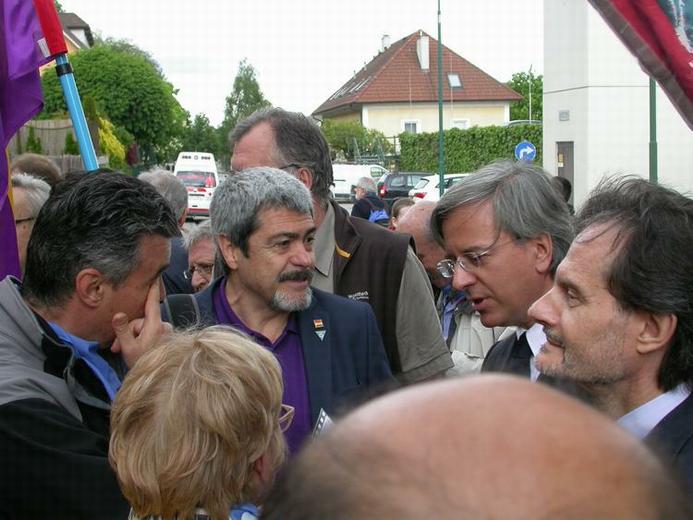
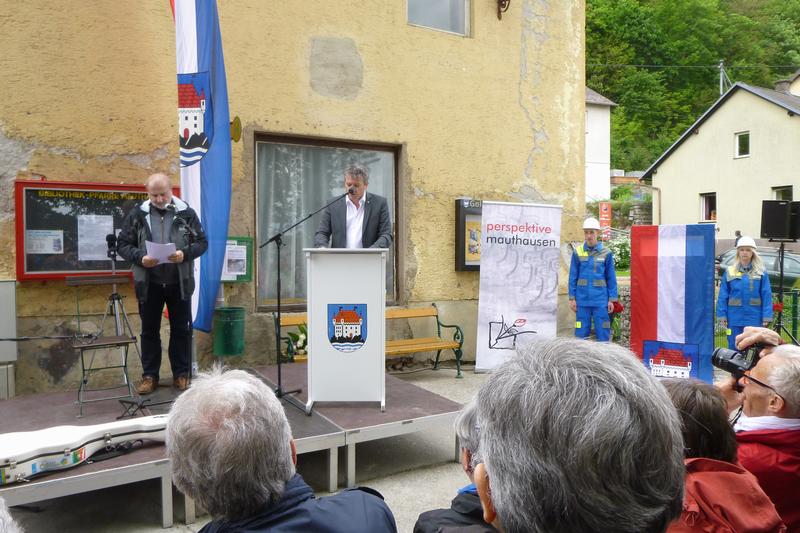
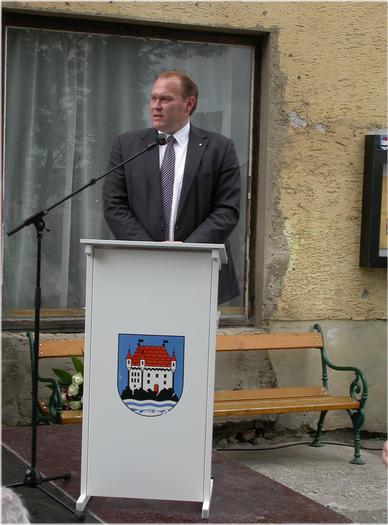
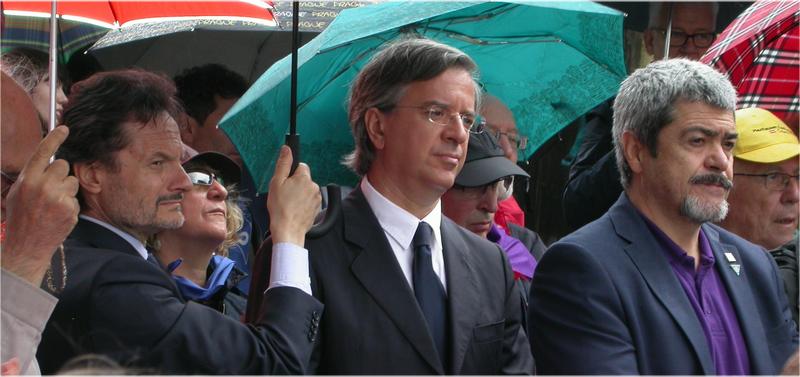
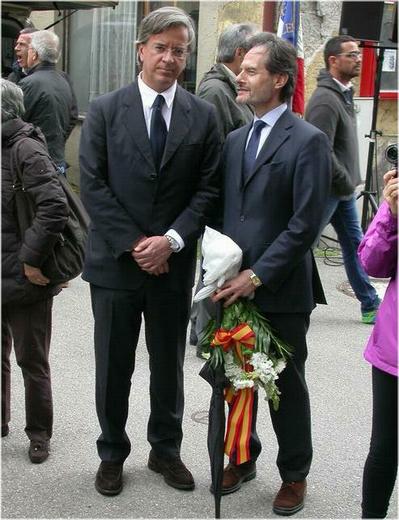

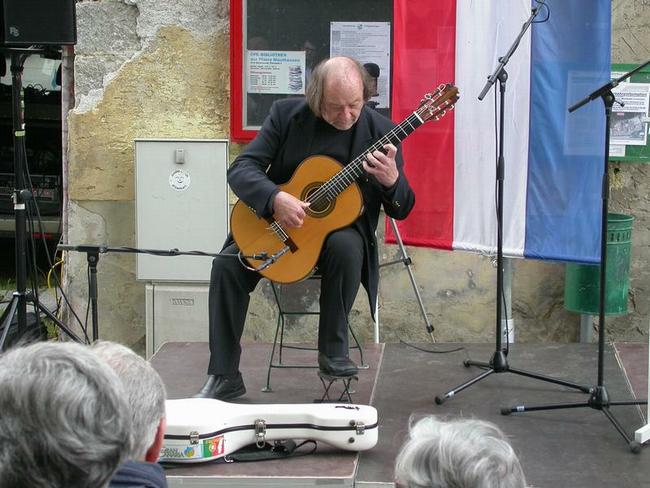

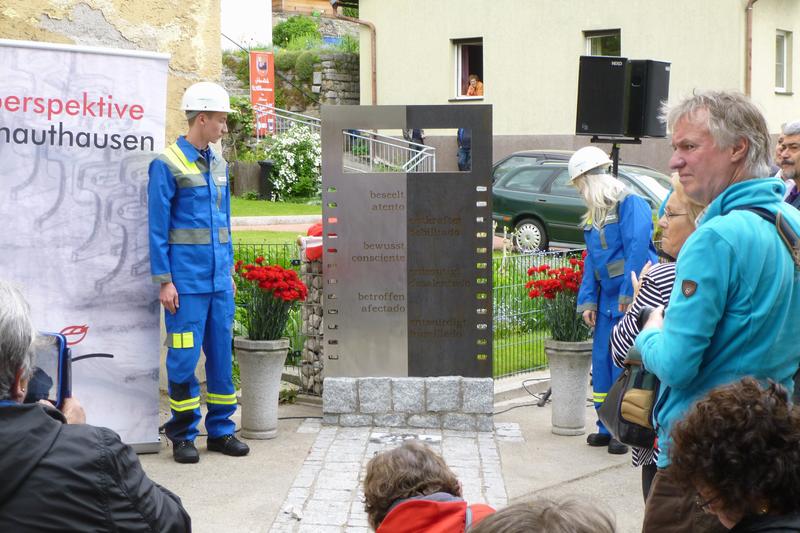
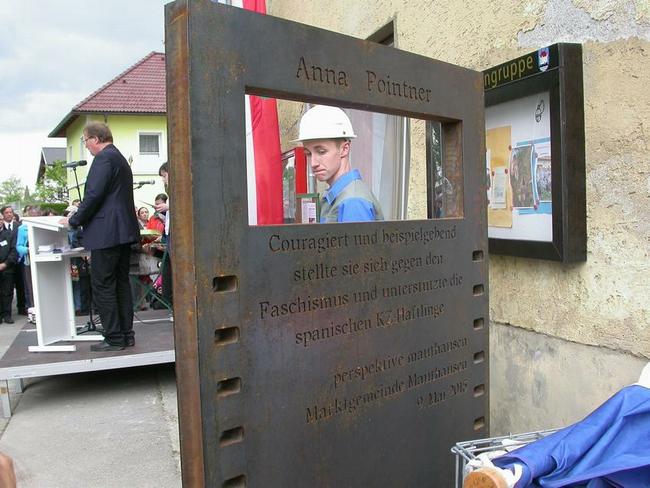
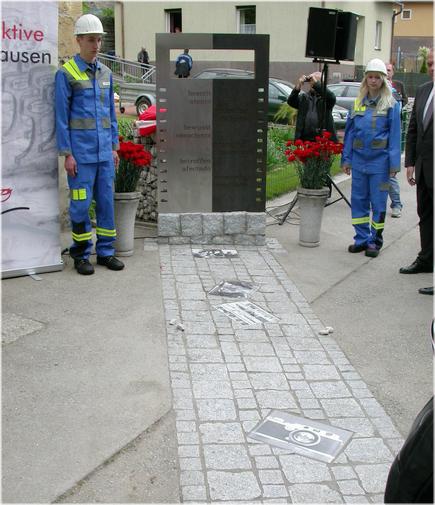
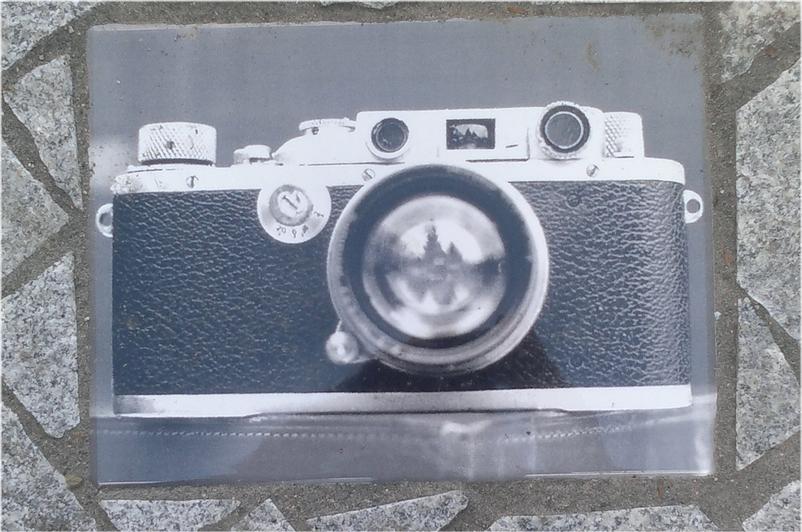
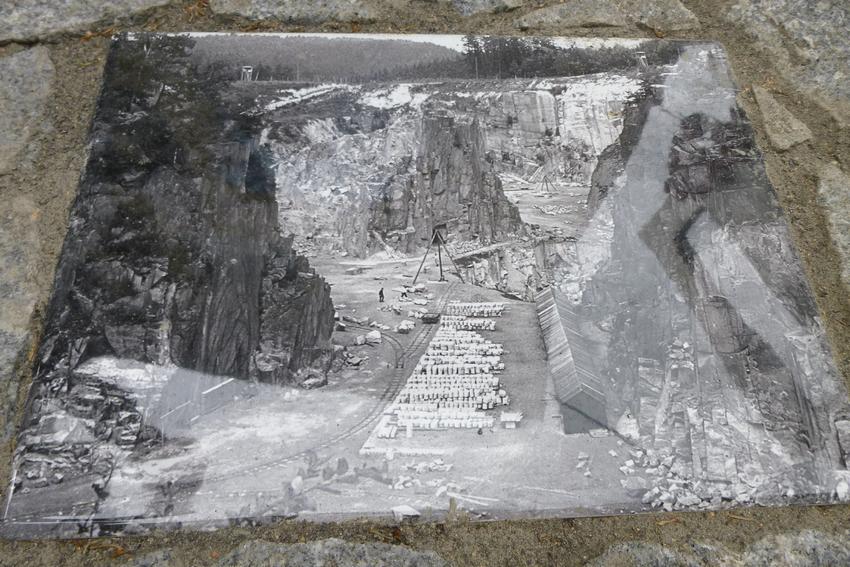

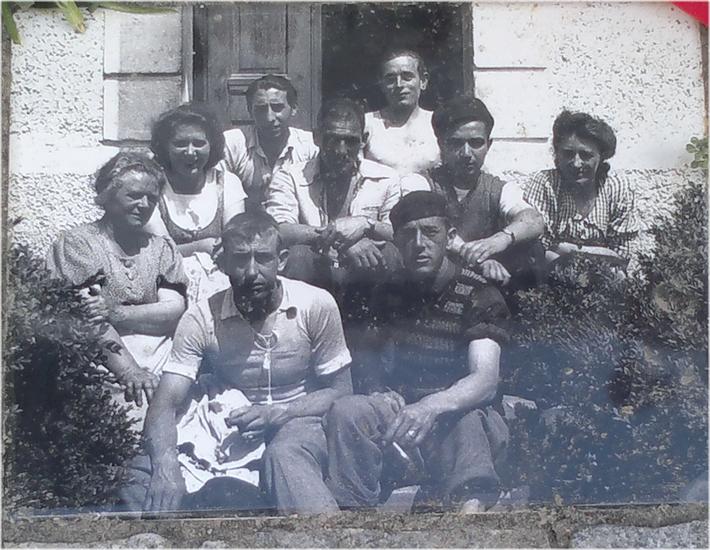
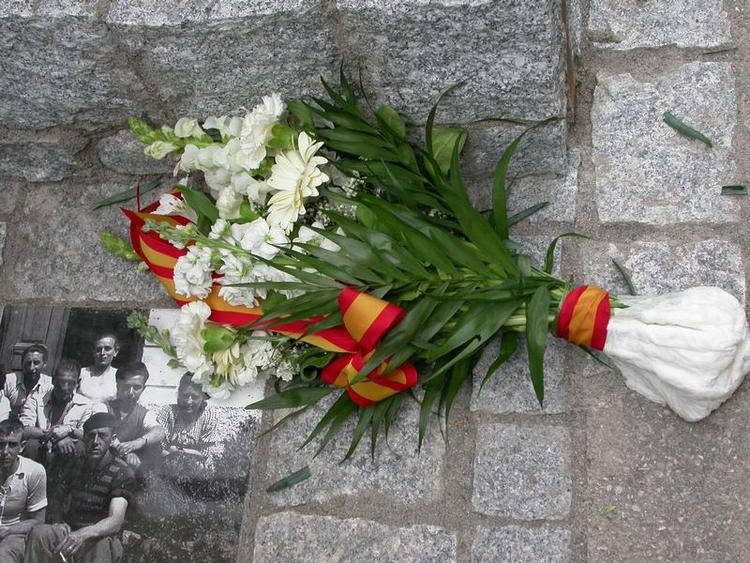
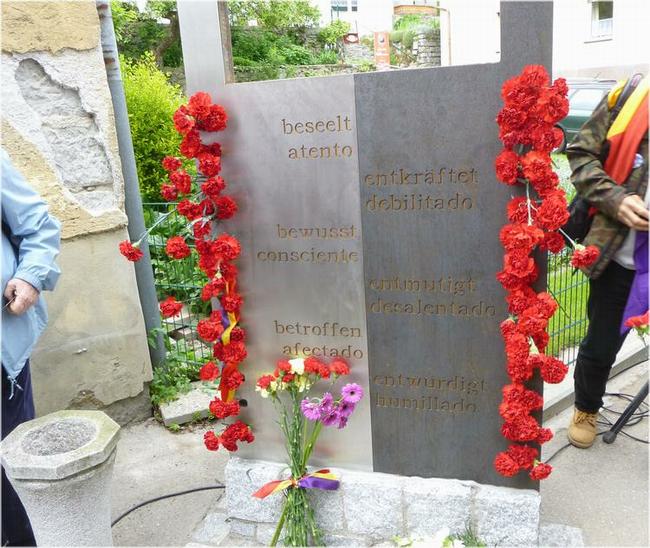
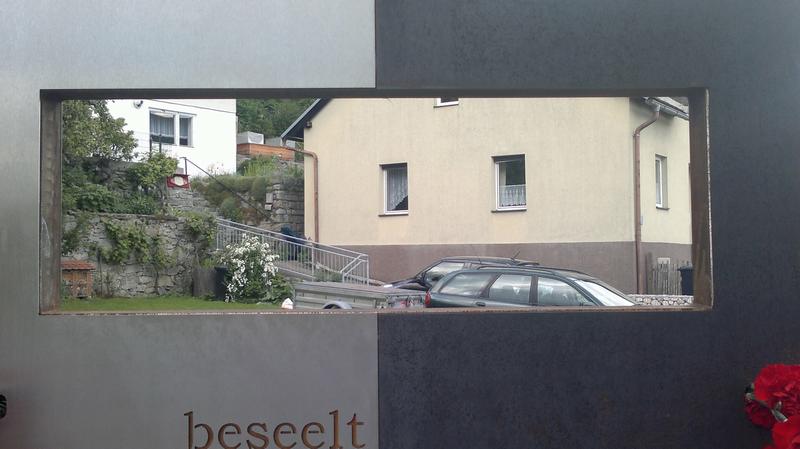 X
XRepresentatives of the Amical de Mauthausen (Barcelona) chat with the representatives of the Spanish Embassy in Vienna.
(Photo Equipo Nizkor, 09May15)Previous Next
D. Enric Garriga Elies, President of the Amical de Mauthausen (Friends of Mauthausen) converses kindly with D Alberto Carnero Fernández, the Spanish Ambassador to the Republic of Austria and D José María Valdemoro Giménez, Minister Counsellor of the Spanish Embassy during the Ceremony to unveil the plaque in memory of Anna Pointner in the town of Mauthausen.
XRepresentatives of the Spanish Embassy in Vienna together with Enric Garriga Elies, President of the Amical de Mauthausen (Friends of Mauthausen, Barcelona).
(Photo Equipo Nizkor, 09May15)Previous Next
From left to right: D José María Valdemoro Giménez, Minister Counsellor of the Embassy of the Kingdom of Spain in Austria; D Alberto Carnero Fernández, the Spanish Ambassador to the Republic of Austria; D. Enric Garriga Elies, President of the "Friends of Mauthausen and Other Camps and of the Spanish victims of Nazism", during the ceremony unveiling the plaque to Anna Pointner in the town of Mauthausen.
XD Alberto Carnero Fernández, the Spanish Ambassador to the Republic of Austria and D José María Valdemoro Giménez, Minister Counsellor of the Embassy. (Photo Equipo Nizkor, 09May15)
Previous Next
From left to right: D Alberto Carnero Fernández, the Spanish Ambassador to the Republic of Austria and D José María Valdemoro Giménez, Minister Counsellor of the Embassy during the ceremony unveiling the plaque in honour of Anna Pointner on 9th May 2015.
XD José María Valdemoro Giménez, Minister Counsellor of the Spanish Embassy in Vienna
(Photo Equipo Nizkor, 09May15)Previous Next
D José María Valdemoro Giménez, Minister Counsellor of the Spanish Embassy in Vienna holding the flower arrangement with the “National” flag which will later be placed below the plaque in honour of Anna Pointner.
XJuan Francisco Ortiz with his guitar enlivening the ceremony in honour of Anna Pointner.
(Photo Equipo Nizkor, 09May15)Previous Next
Juan Francisco Ortiz, the guitarist and a son of a Spanish survivor of the Mauthausen camp, Francisco Ortiz Torres, plays for the attendees of the ceremony to unveil the plaque in honour of Anna Pointner.
XRear view of the plaque in honour of Anna Pointner.
(Photo Equipo Nizkor, 09May15)Previous Next
Rear view of the plaque in honour of Anna Pointner which bears the inscription: "Courageous and exemplary she confronted fascism and helped the Spanish prisoners of the concentration camp". As can be seen the plaque does not refer to the fact that the prisoners were republicans.
XThe flower arrangement left by the Spanish Embassy beneath the commemorative plaque. (Photo Equipo Nizkor, 09May15)
Previous Next
This flower arrangement with the "National" flag was laid by D José María Valdemoro Giménez, Minister Counsellor of the Spanish Embassy in Vienna, which is not pursuant to protocol. The Ambassador was introduced as the representative of the "Spanish Republicans" and was the first to place one of the carnations provided by the organisers before the plaque. This act can be viewed as an appropriation of the memory of the victims by the Spanish Foreign Ministry.
70th anniversary of the liberation of the Nazi camps
 | This document has been published on 14May15 by the Equipo Nizkor and Derechos Human Rights. In accordance with Title 17 U.S.C. Section 107, this material is distributed without profit to those who have expressed a prior interest in receiving the included information for research and educational purposes. |